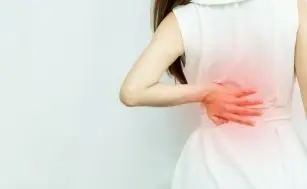Contents

Spinal hernia sounds a bit mysterious due to its medical nature – this is how medicine defines a well-known condition, known as a slipped disc. What does this term actually mean? What role do the discs play in the spine? What causes this ailment? How to recognize her? And most importantly – is it possible to undertake effective treatment in the fight against this condition?
Disk slippage – what does it actually mean?
What are discs really? We often hear about the problem slipped disc — but we can’t always explain what that means. Well, the name “disc” – this is a colloquial replacement for the medical term “intervertebral disc”, designed to cushion the loads to which the spine is constantly exposed. This disc is made of nucleus pulposus, surrounded by a ring of collagen fibers and endplates. During the day, forces press against the disk causing water to be squeezed out of it. This happens while undertaking even minimal activity. At night, the disc absorbs this water and swells. Overloading the disc causes it to move beyond its naturally assigned place and put pressure on the nerves. And this is where the problem begins, defined by doctors as spinal hernia. It can occur along the entire length of the spine, but most often we are dealing with a hernia of the lumbar spine due to the greatest overload to which this section is constantly subjected. In addition, a significant percentage of disc prolapse is a herniated disc in the cervical spine.
Disc loss – symptoms
Pain is associated with all forms of spinal hernia, but depending on the area affected, it covers and intensifies in different parts of the body. Hernia of the lumbar spine manifests itself with severe pain in the back, hips, legs – making it difficult to move. Sometimes there are also pains in the lower abdomen, groin, when passing stool. In turn, the hernia of the cervical spine makes itself felt with pain and stiffness in the neck, making it difficult to move it. An additional indication may be headache or dizziness. Spinal hernia in the thoracic section is manifested by pain radiating to the ribs, especially when laughing, coughing or sneezing.
Spinal hernia — treatment
Since to some extent problems with a slipped disc are a sign of the inevitable aging process, can its symptoms be effectively treated? The first thing we need to do if we regularly suffer from back pain is to undergo a CT scan and magnetic resonance imaging. This will help in making the correct diagnosis. It will be necessary to relieve the spine, take anti-inflammatory drugs that reduce both inflammation and swelling. When you manage to fight the most painful symptom of pain, it is worth starting to move, and then, under the supervision of a diagnostician, undertake physiotherapy or kinesitherapy. All forms of movement should be consulted with a doctor. In the most extreme cases, where the hernia keeps recurring, it will be necessary to undergo hernia surgery.
Hernia in the spine – how can you get this ailment?
A slipped disc can affect the quality of life through severe pain and the associated difficulty in moving. The causes of this ailment should be sought in overloading the spine, although it sometimes happens that it is the result of a previously experienced injury. On the one hand, you can get problems with the spine both by working hard and practicing sports professionally, on the other hand, leading a sedentary lifestyle, lack of physical activity, is also a threat. It is best to choose the effort prophylactically both for age and current physical condition.









